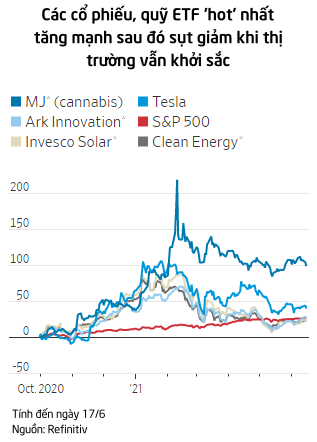Like the dot-com era, Tesla and other bubble stocks are starting to deflate
- Tram Ho
Is the dot-com bubble repeating right before our eyes? This claim may seem odd, but the market has seen parallels between the speculative boom in late 1999 and the first half of 2000 and what has happened over the past nine months in the clean energy, automotive, and energy sectors. electric cars and SPACs.

Whether this trend continues, this will be a negative sign for investors entering the market too late. Stocks favorites – led by Tesla, have fallen between a quarter and a third from their highs this year. However, there are still reasonable factors for investors to expect that, unlike at the turn of the century, the unrest will not spread to the rest of the market.

The similarities today with the dot-com bubble of 2000 are both in performance and in investor behavior. FOMO sentiment in internet stocks in late 1999 pushed the Nasdaq Composite up 83% since late September to an all-time high in March 2000. From last September to this year’s peak, Invesco’s solar industry ETF is up 88%, BlackRock’s clean energy ETF is up 81%, and Ark Innovation’s ETF is up 70%.
Previously, the biggest bubble in the dot-com era was Cisco stock with a 133% gain, and now it is Tesla with 110% from September to a record high. The timing also coincides, this year, the stocks of investors’ favorite sectors have peaked in February and March of this year, while the dot-com high is on March 10. 2000.
After the bubble burst, the performance between then and about mid-June was similar to now, with declines of one-quarter to one-third for the biggest gainers this year and beyond. is the decline recorded in the 2000 quarter of Nasdaq.
In addition, the transaction behavior also has similarities. The end of 1999 was a time of FOMO sentiment in the market, prompting even the dot-com skeptics to buy. At that time, day traders boosted the momentum with the galloping rallies that took place in just one session of internet IPOs.
The final quarter of 2020 marked the moment when Tesla finally appreciated, as electric car stock was officially included in the S&P 500. Furthermore, solar and clean energy became a criterion.” must-have”, has become a pressure on large organizations to issue the required environmental certification. Furthermore, SPACs have replaced the frenetic IPOs of 2000, serving as an outlet for loss-making startups.
Looking back, in the last few months of the Nasdaq boom, the S&P 500 was pretty bleak. By mid-June 2000, the index was just 4% below its March high. That’s not too different from today, as the S&P 500 continues to hit new highs despite the “coins” group. direction” down price.

Back in 2000, many investors believed that the market would be “shielded” by the trend of investment shifting from growth to industries with stable growth, cheap prices and some high-priced stocks. other less-noticed treatment. The S&P 500 nearly peaked in March 2000, before it was reported that the Nasdaq’s explosive rally also slowed the economy. At its 2002 low, the S&P 500 has nearly halved.
This time around, many factors suggest that the market may not fall when the bubbles are gradually deflated. To be sure, the S&P 500 is almost as high as it once was, currently trading at 21.1x forward earnings, according to Refinitiv, compared with 22.6x in June 2020. Again, the investment bias is also shifting from growth stocks to value stocks.
But the drop in stocks in clean energy, electric cars, and even the plunge in Bitcoin has had less impact than when the dot-com bubble burst. The Nasdaq bubble is now worth about half of what the S&P 500 peaked in 2000, when even Tesla and other stocks over the past month have been a fraction of that.
Booming sectors of the market also raise and spend less money than they did in the dot-com era, and these businesses also employ fewer people. If businesses collapse when stocks fall, the impact on the economy will not be too great. Currently, there are few large companies investing in the “new economy” and they are still sticking to the area where they are investing – as well as the trend towards electric vehicles.
Treasury bonds are also a support factor for the market at this time. Back in the 2000s, investors worried about the stock market could make 7% on a 10-year government bond. This is an attractive option, especially given that S&P 500 companies’ E/Ps are only 4%. This time, the S&P 500’s E/P is similar, but the Treasury yield is just 1.5% lower.
Of course, both the economy and the stock market now face other threats, but the bubble over the past 9 months seems like a “tiny” balloon that has disappeared several times over the course of time. the post-2009 bull market.
Source : Genk
